ISSN ONLINE(2319-8753)PRINT(2347-6710)
ISSN ONLINE(2319-8753)PRINT(2347-6710)
Hayat Errifi 1, Abdenacceur Baghdad 2, Abdelmajid Badri 2
|
| Related article at Pubmed, Scholar Google |
Visit for more related articles at International Journal of Innovative Research in Science, Engineering and Technology
Microstrip patch antenna is one of the important elements in modern wireless communication systems and hence its design optimization is an important aspect for improving the overall performance of the system. In this paper Genetic Algorithm optimization technique has been utilized in HFSS software for optimization of the aperture coupled patch antenna dimensions in order to achieve better return loss and height directivity. The microstrip patch antenna is designed to operate in C band with the centre frequency at 7GHz and various important performance metrics of the patch antenna are analyzed for performing comparative analysis between un-optimized patch design and optimized patch design. A program has been developed in MATLAB for obtaining the patch dimensions based on theoretical formulas.
Keywords |
| Patch antenna, HFSS, Genetic Algorithm, Return Loss, and Directivity. |
INTRODUCTION |
| Microstrip patch antennas have been extensively used in many applications due to their low profile, ease of manufacture, and the possibility of integration with other circuits. However, most patch antennas provide a wide beamwidth and low radiation efficiency. |
| In order to overcome the shortcomings of the patch antenna it is important to make an optimal antenna design for best performance. Various existing optimization algorithms can come handy in this case and genetic algorithm which is one of the global optimization algorithms has been used widely in the past by antenna designers [4] for the optimization of the patch shape and size in order to achieve better overall performance of the antenna. In this paper genetic algorithm has been used for optimization of aperture coupled rectangular microstrip patch antenna (ACMPA) dimensions, It was exactly used to optimize the patch length, the slot dimensions in the ground plane and the dimensions of the feed line. The work has been performed by interfacing the genetic algorithm to Ansoft High Frequency System Simulator (HFSS). The paper is organized as follows: Section 2 presents a design approach for aperture coupled rectangular patch antenna, Section 3 gives a brief about genetic algorithm and the flowchart used, in section 4 simulation results are presented and finally in section 5 conclusion is drawn. |
APERTURE COUPLED PATCH ANTENNA DESIGN |
| An aperture coupled patch antenna eliminates the direct electrical connection between the feed and radiating conductors by employing two dielectric substrates separated by a ground plane. This allows independent optimization of both the microstrip transmission line feed and radiating patch; patch and feed line are electromagnetically coupled through an aperture made on the ground. Such a design can be well explained with the help of following diagram: |
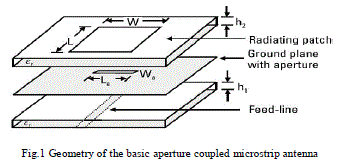 |
| 2.1 Design of the patch |
| Mostly the length (L) and width (W) of the patch can be calculated using the parameters like height of the substrate (h2) below the patch, the dielectric constant (Ãâ ÃÂr2) and the resonant frequency (fr) which are given by the formulas [3]: |
 |
| Where, c is the free-space velocity of light and fr is the resonant frequency of the antenna. |
| 2.2 Design of the microstrip feed line |
| Usually 50Ω microstrip line is used to feed the radiating patch. Feed line width decides the characteristic impedance of the feed line, so chosen to get the required impedance. Also for maximum coupling, slot is centered below the patch and the feed line must be placed perpendicular to the center of the slot. |
| 2.3 Design of the Aperture |
| The amount of the coupling between the patch and feed line is determined by the aperture, so aperture has a very important role in the microstrip antenna with aperture coupled feeding. Mostly the length of the aperture (La) and the stub length are considered and width of the aperture (Wa) is small and has only a small effect on the antenna behavior. It was fixed at 1mm. |
| 2.4 Design of the stub |
| Stub length is considered as the length of the feed line after the slot. It is used to tune the excess reactance of the aperture. |
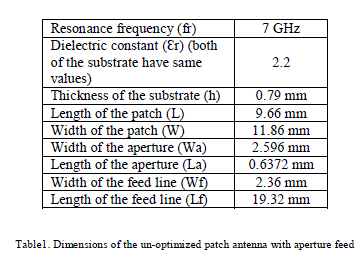 |
| Table 1 shows the dimension of the ACMPA calculated by Matlab. This calculator makes use of the formulas presented in section 2. The benefit of such calculator is the reduction in time for calculating the patch dimensions for different set of inputs which otherwise has to be done manually. |
GENETIC ALGORITHM |
| GA’s are the search algorithms based on the mechanics of natural selection and natural genetics. They are stochastic search procedures modeled on the Darwinian concepts of natural selection and evolution. In GA a set or population of potential solutions is caused to evolve towards a global optimal solution. GA optimization technique is different from local optimization techniques which produce results that are highly dependent on the starting point or initial guess. GA’s can handle discontinuous and non differentiable functions. They are also well suited for constrained optimization problems. |
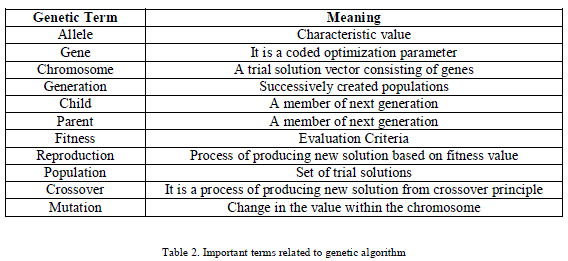 |
| Table 2 gives a brief about various important terms related to genetic algorithm. Fitness function is the only connection between the physical problem being optimized and the genetic algorithm. Fitness function is used to assign a fitness value to each of the individuals in the GA population. Fitness value returned by the fitness function is in some manner proportional to the goodness of a given tried solution in generation. GA starts with coding the unknown variables into chromosome, randomly generating N number of solutions. The chromosomes are weighted based on their fitness function values and the inferior ones will be updated by selection, crossover and mutation operations. Optimisation is terminated when stopping criteria is met. |
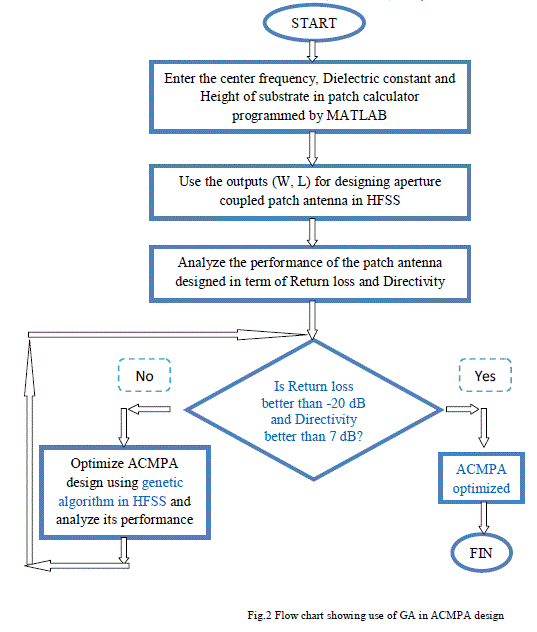 |
| Figure 2 shows the flow chart used to design ACMPA. First, we calculate the antenna parameters then we analyze its performance, if the results are not satisfied we use genetic algorithm optimization. Optimization is terminated when criteria is met. |
SIMULATION RESULTS |
| Patch antenna has been designed in HFSS software (Fig.3) and various important performance metrics are measured to analyze the performance of the designed ACMPA. |
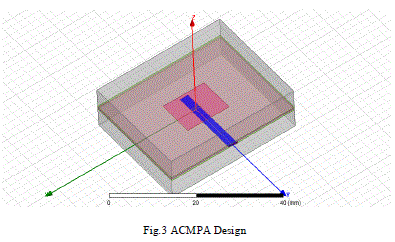 |
| The figure above represent the design model of aperture coupled microstrip patch antenna with HFSS software. We used the dimensions calculated in section II. |
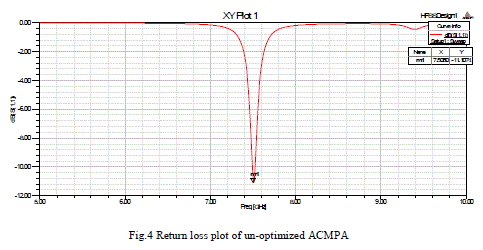 |
| The return loss should be minimal at resonance frequency for better performance; the return loss plot for the designed antenna is shown in figure 4. It shows a bad value and the resonance frequency is not exactly at 7 GHz. This in accuracy in terms of the center frequency is removed by optimizing the patch using genetic algorithm in HFSS environment. Genetic algorithm is one of the EM optimization techniques integrated with Ansoft HFSS. This can be utilized to reduce the efforts of manual tuning of the patch dimensions in order to achieve the desired goal. |
| Genetic Algorithm parameters are given below: |
| Error function limit = 0.001 Mutation Rate = 0.2 |
| Standard deviation = 0 Crossover Rate = 0.3 |
| Maximum number of generations = 1000 Random search = 0 |
| Population size = 50 Iterations = 50 |
| Optimized patch exhibits return loss of -28.24 dB at exactly 7 GHz. Return loss plot of the optimized patch antenna is shown in Figure 5. |
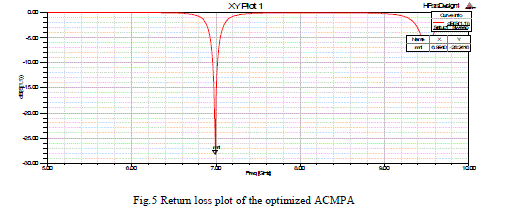 |
| VSWR: it is used to describe the performance of an antenna when attached to transmission line. It is the measure of how well the antenna terminal impedance is matched to the characteristic impedance of transmission line. Ideal value of SWR is unity indicating that there is no standing wave on the line. Un-optimized ACMPA has SWR of 1.8 at 7.5 GHz. VSWR variation with frequency of the optimized patch antenna is shown in Figure 6. From this plot it is clear that the optimized patch has a SWR of 1.08 at 7GHz. |
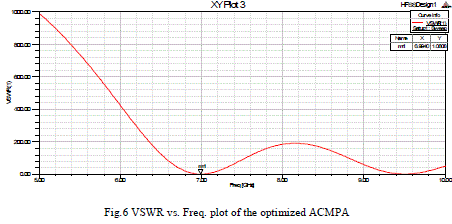 |
| Input impedance plot: One of the most important requirements of a good patch design is that its input impedance should be purely real at the frequency where patch resonates. Figure 8 shows the input impedance variation in function of the frequencyfor the optimized patch. The patch designed has the input impedance of 92Ω at 7.5GHz and optimized patch has input impedance of 51Ω at 7 GHz, so better impedance matching is achieved in the optimized patch. (Fig.7) |
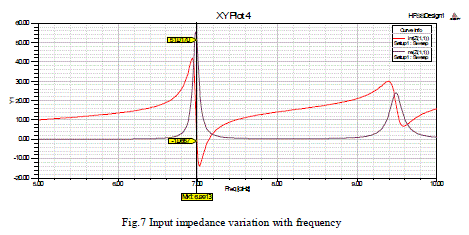 |
| Directivity: It is one of the most important parameter of the patch antenna; Figure 8 shows the three dimensional polar plot of the optimized ACMPA in which the maximum directivity achieved is 7.13 dB at 7GHz which is 29 % more as compared to the un-optimized MPA. 3dB beam width of the optimized patch is 73 degrees. |
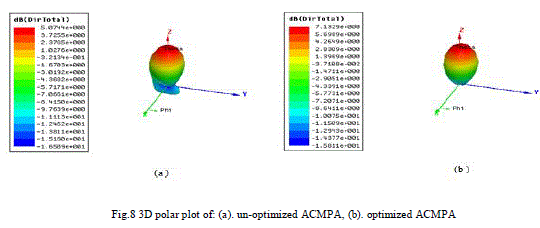 \ \ |
| 2-D Radiation pattern plot for Φ=0° at 7 GHz for un-optimized ACMPA and optimized ACMPA is shown in Figure 9, Removal of secondary lobes can be seen. |
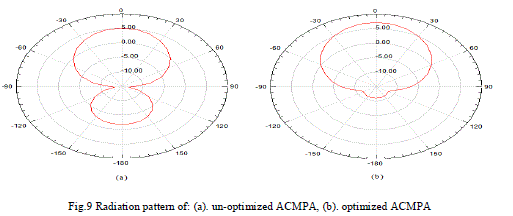 |
| The comparison between un-optimized and optimized ACMPA is shown in table 3. |
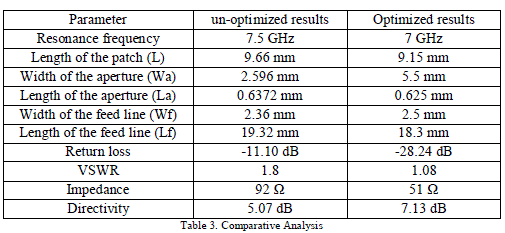 |
| From the above table it can be seen that the performance of the optimized patch antenna using genetic algorithm is better than the un-optimized patch in terms of return loss, VSWR, Input impedance and directivity. |
CONCLUSION |
| A rectangular microstrip patch antenna coupled to microstrip line through a small rectangular aperture in ground plane has been designed and optimized. The GA is very precise and fast comparing to other techniques because it encodes the parameters and the optimization is done with the en-coded parameters. From the simulation results of HFSS presented in section 4 it can be concluded that the optimized patch antenna using Genetic Algorithm exhibits better return loss and radiation properties as compared to the un-optimized patch designed using theoretical formulas. The optimized patch exhibits 29 % more gain and 17.14 dB better return loss as compared to un-optimized patch antenna design. Future research work should aim at utilizing Genetic Algorithm optimization technique to improve the performance of the patch antenna array. |
References |
|